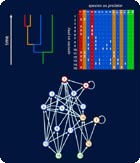séminaire du pôle évolution du vivant – mercredi 30 avril 2008
 The importance of phylogeny to understand the structure of food webs
The importance of phylogeny to understand the structure of food webs
Louis-Felix Bersier, Unit of Ecology and Evolution, Department of Biology, University of Fribourg (Switzerland)
mercredi 30 avril 2008, à 11 heures, amphithéâtre Monge, bâtiment Gabriel
Understanding the processes underlying food-web structure and organization remains one of the major tasks of ecology. While first attempts were mostly based on niche theory, with body-size of species imposing a hierarchical structure for consumer species, it has been recently suggested that phylogenetic constraints may be more fundamental to understand who eats whom in natural communities. Models of food-web structure built on basic evolutionary assumptions are able to adequately reproduce the topology of real food webs. Here, we analyze different implications of phylogenetic constraints on trophic structure, and present preliminary results. Our exploration of the relationship between trophic and taxonomic similarity in food webs shows that phylogeny and trophic structure are closely linked. Interestingly, the relationship is stronger for trophic similarity between prey (similarity measured by shared predators species, or predatory similarity) than between consumer species (similarity measured by shared prey species, or dietary similarity). When relating body mass of prey and predators, slopes of major axis regressions within taxonomic groups differ markedly from the global pattern; similar differences between taxonomic levels appear when exploring the relationship between body mass of predators and the range in body mass of their prey, and vice versa. These results are important to understand how evolutionary processes shaping body sizes can affect food-web structure.
- kc_data:
- a:8:{i:0;s:0:"";s:4:"mode";s:0:"";s:3:"css";s:0:"";s:9:"max_width";s:0:"";s:7:"classes";s:0:"";s:9:"thumbnail";s:0:"";s:9:"collapsed";s:0:"";s:9:"optimized";s:0:"";}
- kc_raw_content:
 The importance of phylogeny to understand the structure of food webs
The importance of phylogeny to understand the structure of food websLouis-Felix Bersier, Unit of Ecology and Evolution, Department of Biology, University of Fribourg (Switzerland)
mercredi 30 avril 2008, à 11 heures, amphithéâtre Monge, bâtiment Gabriel
Understanding the processes underlying food-web structure and organization remains one of the major tasks of ecology. While first attempts were mostly based on niche theory, with body-size of species imposing a hierarchical structure for consumer species, it has been recently suggested that phylogenetic constraints may be more fundamental to understand who eats whom in natural communities. Models of food-web structure built on basic evolutionary assumptions are able to adequately reproduce the topology of real food webs. Here, we analyze different implications of phylogenetic constraints on trophic structure, and present preliminary results. Our exploration of the relationship between trophic and taxonomic similarity in food webs shows that phylogeny and trophic structure are closely linked. Interestingly, the relationship is stronger for trophic similarity between prey (similarity measured by shared predators species, or predatory similarity) than between consumer species (similarity measured by shared prey species, or dietary similarity). When relating body mass of prey and predators, slopes of major axis regressions within taxonomic groups differ markedly from the global pattern; similar differences between taxonomic levels appear when exploring the relationship between body mass of predators and the range in body mass of their prey, and vice versa. These results are important to understand how evolutionary processes shaping body sizes can affect food-web structure.
- extrait:
- lien_externe:
- titre:
- The importance of phylogeny to understand the structure of food webs
- intervenant:
- Louis-Felix Bersier
- date:
- mercredi 30 avril 2008
